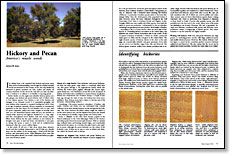
Synopsis: Jon W. Arno says he’s always been surprised that hickory and pecan aren’t used more often in furnituremaking. In this article, he discusses their history, their cost (relatively low), how to identify them and work with them, and the differences between true hickories and pecan hickories. Side information details the woods and where they grow, as well as their characteristics.
I’ve always been a bit surprised that hickory and pecan aren’t often used in furnituremaking, even though lots of these beautiful woods are harvested in this country. In fact, the only hardwoods harvested in greater quantities are oaks, poplars and maples, all common furniture woods. About the only time you hear any reference to hickory is in relation to ax handles or sporting goods.
Timber dealers sort the eight most valuable hickory species into two groups, true hickory and pecan hickory, each of which refers to four distinct species. True hickory is one of the heaviest and strongest of our domestic woods. It is remarkably springlike and very resilient when exposed to repeated bending and shock. Even in an age of synthetic materials, hickory maintains its international reputation as the first choice for tool handles, and it is also used for sports equipment, pallets and crates. Despite its iron-like hardness, you can steam-bend hickory easily and you can machine its creamy white sapwood and light-tan heartwood to a crisp edge. And this close-grained wood finishes well and doesn’t require fillers. Pecan hickory has the same attributes as true hickory, although it isn’t quite as hard and dense, and therefore it isn’t quite as strong. But pecan is easier to work and its reddish-brown heartwood often has a more mellow figure.
In this article I’ll tell you a little more about these attractive woods and their working characteristics, and I’ll help you identify them. I think you’ll find that hickory, and particularly pecan, Carya illinoensis, are worth a closer look before you plan your next furniture project.
History of a tough family
True hickories and pecan hickories are from the same genus, Carya, which is commonly called hickory. This genus belongs to the Juglandaceae family, which also includes the walnut genus, Juglans. Although this ancient angiosperm family was once distributed around the world, all species of hickory and walnut were annihilated in ancient Europe by glaciers. Walnut was reintroduced into Northern Europe a couple of millenia ago through the trade of nuts, but hickory was never re-established. Thus, hickory never had a chance to become part of the European cabinetmaking tradition.
From Fine Woodworking #87
For the full article, download the PDF below:
Fine Woodworking Recommended Products

AnchorSeal Log and Lumber End-Grain Sealer

Ridgid R4331 Planer

DeWalt 735X Planer





















Log in or create an account to post a comment.
Sign up Log in